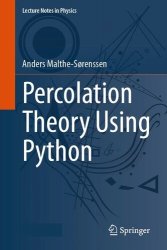Percolation Theory Using Python
- Добавил: literator
- Дата: 30-06-2024, 17:14
- Комментариев: 0
 Название: Percolation Theory Using Python
Название: Percolation Theory Using PythonАвтор: Anders Malthe-Sørenssen
Издательство: Springer
Год: 2024
Страниц: 221
Язык: английский
Формат: pdf (true), epub
Размер: 41.2 MB
This course-based textbook delves into percolation theory, examining the physical properties of random media—materials characterized by varying sizes of holes and pores. The focus is on both the mathematical foundations and the computational and statistical methods used in this field. Designed as a practical introduction, the book places particular emphasis on providing a comprehensive set of computational tools necessary for studying percolation theory.
Readers will learn how to generate, analyze, and comprehend data and models, with detailed theoretical discussions complemented by accessible computer codes. The book's structure ensures a complete exploration of worked examples, encompassing theory, modeling, implementation, analysis, and the resulting connections between theory and analysis.
Beginning with a simplified model system—a model porous medium—whose mathematical theory is well-established, the book subsequently applies the same framework to realistic random systems. Key topics covered include one- and infinite-dimensional percolation, clusters, scaling theory, diffusion in disordered media, and dynamic processes. Aimed at graduate students and researchers, this textbook serves as a foundational resource for understanding essential concepts in modern statistical physics, such as disorder, scaling, and fractal geometry.
Percolation is the study of connectivity of random media and of other properties of connected subsets of random media. In this book, we will address the physical properties of such media, develop the underlying mathematical theory and the computational and statistical methods needed to discuss the physical properties of random media. In order to do that, we will develop a simplified model system, a model porous medium, for which we can develop a well-founded mathematical theory, and then afterwards we can apply this model to realistic random systems. The basic terms in percolation theory are introduced, and you learn how to generate, visualize and measure on percolation systems in Python.
Скачать Percolation Theory Using Python
Внимание
Уважаемый посетитель, Вы зашли на сайт как незарегистрированный пользователь.
Мы рекомендуем Вам зарегистрироваться либо войти на сайт под своим именем.
Уважаемый посетитель, Вы зашли на сайт как незарегистрированный пользователь.
Мы рекомендуем Вам зарегистрироваться либо войти на сайт под своим именем.
Информация
Посетители, находящиеся в группе Гости, не могут оставлять комментарии к данной публикации.
Посетители, находящиеся в группе Гости, не могут оставлять комментарии к данной публикации.
